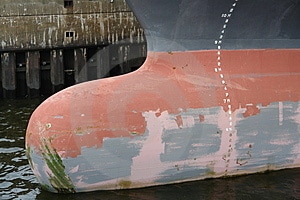With the Pedal to the Metal we sailed away from Puerto Caldera soon making up for the lost time. I knew the weather was going to be as smooth as could be and that would all help with making speed. With no adverse wind around, nor having been around for the last 7 days, the currents would be predictable and they were. Along the coast of Costa Rica and Nicaragua they gave us an extra push of 1.5 knots until we came abreast of Guatemala. By now we were about 80 miles from land due to this curve in the continent, while we were on a straight course. Here the current keeps following the land but when near Puerto Quetzal the land becomes straight again so the current is directed back to the south and then we get that 1.5 knot against us for about 5 hours. Still over the whole distance between Puerto Caldera and Hualtalco we have on average the current with us and that is always pleasant.
A ships model pulled through a wave tank. (Photo Courtesy: Marin, Netherlands, a company which has one of the most advanced testing stations in the world)
To optimize speed, the trim of the ship is also important. Each ship has an optimum trim where the water creates the least resistance when the ship is ploughing through it. The bulbous bow is of great importance but you have to ensure that it is at the right depth otherwise it does not do much good. When a ship is designed the optimum hull form for its size is tested in a wave tank. This is a sort of advanced swimming pool where the conditions are so designed that they carefully mimic real life in all its variations. A ships model is pulled through the tank under various wave conditions and speeds and eventually the optimum hull form is found for the particular design that a company wants.
However real life tends to be just that bit different from theory, so that when the ship starts sailing the bridge team is trying out several things to see what works best. The ship is now fully loaded with hotel stores, passengers on board, full or not full with water, bunker tanks full or not full, a whole number of things that might be different than what was envisioned on paper. Experience with the ship brings a general average to a ships operational setup and that means that we can, to a certain extent, tinker with the optimum trim for a certain loading and sailing situation. For the Statendam and the whole S-class that optimum sailing situation is about 50 to 60 centimeter (2 feet) by the bow. Then the bulbous bow pierces through the waves in an optimum way and reduces the friction. It can make up to a knot difference in speed. The lower the speed, the less pronounced the difference is but it all helps and thus the navigation officer in charge of stability tries with ballasting to keep that optimum trim.
 The main reason for an officer to be looking after the ships stability is to keep the ship stable, e.g. upright. Plus if the ship would be holed, to ensure that there is enough buoyancy to keep it afloat as long as it is within the parameters of its design.
The main reason for an officer to be looking after the ships stability is to keep the ship stable, e.g. upright. Plus if the ship would be holed, to ensure that there is enough buoyancy to keep it afloat as long as it is within the parameters of its design.
The bulbous bow of the ship with the draft marks. The green stripes on the bow are caused by the anchor chain damaging the anti fouling paint on the hull and thus giving marine growth the chance to attach itself. That is also not good for the ships speed.
A medium sized cruise ship such as the Statendam is divided in 14 watertight compartments. The criteria are that when the two biggest ones are filled with water, then the ship should still stay afloat. To ensure this, before each port a stability calculation is carried out to make sure that the ship has enough buoyancy to meet those criteria.
We do that before departure from a port so we can check the computer calculation with the draft marks. The stability computer gets constant input from all the tanks on board and uses that to calculate, in theory, what the situation is. That results in a computer draft. By checking the real draft marks against the theoretical drafts calculated by the computer, we can see if it is correct. This is considered so important that when the calculation is printed out, the Captain and Chief Officer sign it. A double check to ensure that indeed we are sailing above the red line of safety.
Tonight we are going through the Gulfo de Tehantepec and if my calculations are right, there should be no more than 3o knots of wind. That will be different after tomorrow when the wind it supposed to pick up in the Caribbean Sea and this funnel wind will start really blowing. We will have however a wind still and sunny day in Hualtalco. That means warm temperatures, reaching into the high 80’s.


Leave a Reply